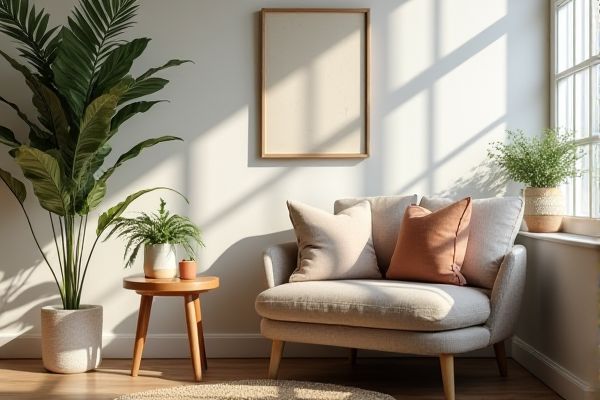
End tables are typically placed beside sofas or chairs to hold lamps, drinks, or decorative items, while side tables are more versatile pieces used throughout a room for additional surface space. Discover the key differences and find the perfect table to complement Your living area by reading the rest of the article.
Table of Comparison
| Feature | End Table | Side Table |
|---|---|---|
| Location | Placed at the end of a sofa or seating area | Positioned beside chairs, beds, or sofas for easy access |
| Size | Typically larger and sturdier to hold lamps, books, and decor | Usually smaller and lighter for flexible placement |
| Purpose | Supports lamps, drinks, and decorative items near seating | Offers convenient surface for essentials within reach |
| Design | Often matches or complements the main sofa set | More varied styles to suit different spaces and uses |
| Usage | Common in living rooms near sofas or sectionals | Versatile usage in living rooms, bedrooms, and hallways |
Definition: What Is an End Table?
An end table is a small, versatile piece of furniture typically placed at the end of a sofa or beside a chair, designed to hold lamps, drinks, or decorative items. Unlike side tables, end tables are usually smaller and primarily serve to complement seating areas in living rooms or lounges. Their compact size and strategic placement make them essential for both functionality and aesthetic balance in interior design.
Definition: What Is a Side Table?
A side table is a small, versatile piece of furniture designed to sit beside a chair, sofa, or bed, providing a convenient surface for items like lamps, books, or drinks. Unlike end tables, side tables can be more varied in shape and height, often used to complement seating areas without dominating the space. Their primary function is to enhance accessibility and organization in living rooms, bedrooms, or lounges.
Key Differences Between End Tables and Side Tables
End tables are typically placed at the ends of sofas or seating areas, serving as functional surfaces for lamps, drinks, or decorative items, while side tables are more versatile and can be positioned beside chairs, beds, or in hallways. End tables often feature a square or rectangular shape to fit snugly next to furniture, whereas side tables come in various shapes and sizes to complement different spaces and styles. Your choice depends on the specific placement and purpose, with end tables primarily designed for living room use and side tables offering broader functionality throughout your home.
Design and Style Variations
End tables and side tables offer diverse design and style variations tailored to different living spaces, ranging from minimalist modern designs with clean lines to ornate traditional styles featuring intricate carvings. Materials commonly used include wood, metal, glass, and acrylic, influencing both the aesthetic and durability of these tables. Size and shape options vary widely, with popular choices including square, round, and rectangular forms that complement sofas, chairs, or beds while enhancing room decor.
Common Materials Used for Both Tables
End tables and side tables are commonly crafted from wood, metal, glass, or a combination of these materials, providing durability and style versatility for any living space. Wood varieties such as oak, walnut, and pine offer a natural aesthetic, while metal frames in steel or iron contribute to a modern or industrial look. Glass tops are often paired with metal or wooden bases to create a sleek, contemporary design that enhances light flow and visual openness.
Best Placement in Home Interiors
End tables are best placed at the ends of sofas or beside armchairs, providing convenient surfaces for lamps, drinks, or decor in living rooms. Side tables offer more flexible placement options, including next to beds, in hallways, or as accent pieces in corners, enhancing room functionality without occupying much space. Your choice depends on the room layout and purpose, ensuring ease of access and complementing your home's aesthetic.
Functional Uses: End Table vs Side Table
End tables primarily function as small surfaces placed beside sofas or chairs to hold lamps, drinks, or decorative items within easy reach. Side tables may serve a similar purpose but often provide additional versatility, fitting in various spaces such as next to beds or in hallways. Your choice between an end table and a side table depends on where you need convenient storage or display space to complement your room's layout.
Choosing the Right Table for Your Space
Selecting the right table for your space depends on its size and function; end tables typically fit beside sofas and chairs, offering convenient surfaces for lamps and drinks, while side tables provide versatile placement options throughout living areas and bedrooms. Consider dimensions and style to ensure the table complements existing furniture and meets your storage or display needs. Prioritize lightweight tables if mobility is important, and storage features like drawers or shelves for added practicality.
Popular Trends in End and Side Tables
End tables and side tables are trending with sleek, multifunctional designs that blend storage and style, favoring materials like natural wood, metal accents, and tempered glass for durability and aesthetic appeal. Popular choices include nesting tables and geometric shapes that maximize space and versatility, aligning with modern minimalist and mid-century decor trends. Your living area can benefit from these pieces as they combine practicality with contemporary flair, serving as both functional surfaces and statement decor.
Tips for Decorating with End and Side Tables
Maximize small spaces by choosing end tables with storage drawers or shelves for decluttering essentials near seating areas. Style side tables with decorative items like plants, books, or lamps to add personality while maintaining functionality. Select pieces with complementary materials and colors to create a cohesive look that enhances the room's overall aesthetic.
 homyna.com
homyna.com